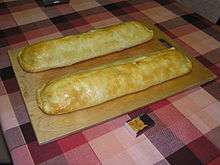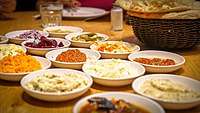Strudel
A strudel (/ˈstruːdəl/, German: [ˈʃtʁuːdl̩]) is a type of layered pastry with a filling that is usually sweet. It became popular in the 18th century throughout the Habsburg Empire. Strudel is part of Austrian cuisine but also common in the other Central European cuisines.
 Apple strudel made in the Czech Republic | |
| Type | Pastry |
|---|---|
| Place of origin | Austrian Empire |
| Main ingredients | Filo pastry |
The oldest strudel recipes (a Millirahmstrudel and a turnip strudel) are from 1696, in a handwritten cookbook at the Wienbibliothek im Rathaus (formerly Wiener Stadtbibliothek).[1] The pastry descends from similar Near Eastern pastries (see baklava and Turkish cuisine).[2]
Etymology
Strudel is an English loanword from German.[3] The word derives from the German word Strudel, which in Middle High German literally means "whirlpool" or "eddy".[4][5][6]
Pastry

The best-known strudels are Apfelstrudel (German for apple strudel) and Topfenstrudel (with sweet soft quark, in Austrian German Topfen), followed by the Millirahmstrudel (Milk-cream strudel, Milchrahmstrudel). Other strudel types include sour cherry (Weichselstrudel), sweet cherry, nut filled (Nussstrudel), Apricot Strudel, Plum Strudel, poppy seed strudel (Mohnstrudel), and raisin strudel.[7] There are also savoury strudels incorporating spinach, cabbage, potato, pumpkin, and sauerkraut,[8] and versions containing meat fillings like the Lungenstrudel or Fleischstrudel.
Traditional strudel pastry differs from puff pastry in that it is very elastic. It is made[9] from flour with a high gluten content, water, oil and salt, with no sugar added. The dough is worked vigorously, rested, and then rolled out and stretched by hand very thinly with the help of a clean linen tea towel[10] or kitchen paper.[11] Purists say that it should be so thin that you can read a newspaper through it. A legend has it that the Austrian Emperor's perfectionist cook decreed that it should be possible to read a love letter through it. The thin dough is laid out on a tea towel, and the filling is spread on it. The dough with the filling on top is rolled up carefully with the help of the tea towel and baked in the oven.
Apples
Regional apple varieties prevail with choice based on firm to semi-firm texture once baked. Tasting notes are acidic with apple flavor. Varieties include Belle de Boskoop, Stayman Winesap, Gravenstein, Newtown Pippin, Bramley's Seedling, Karmijn de Sonnaville, Zabergau Reinette, Yellow Transparent, Calville Blanc, Granny Smith, Glockenapfel, Jonagold, Jonathan, Northern Spy, and Rhode Island Greening.[12]
See also
References
- N.N.: Koch Puech. Ein Vortrefflich und Gerechtes Koch Puech, darinen bey 1350 Rahre und Kostbahre Speisen begreiffen Nemblichen vor aller Hand Pastetten und Dortten gebachenen Sulzen ... [!] Unterschudliche guete Suppen auch von Fischen Und dergleichen andrer Wahrmen Speisen mehr zu Kochen und zue Zurichten, 1696. Vienna City Library, Manuscript department, H.I.N. 18845
- Friederich Kunz: Die Strudelfamilie - eine Wiener Mehlspeisendynastie mit orientalisch-europäischem Stammbaum, in "backwaren aktuell", 2/11 Archived 2012-07-22 at the Wayback Machine
- "Words in English: Loanwords". rice.edu.
- Oxford English Dictionary, second edition. 1989.
- From Old High German stredan "to bubble, boil, whirl, eddy", according to etymonline.
- Seebold, Elmar. 1999. Kluge Etymologisches Wörterbuch der deutschen Sprache, 23rd edition. Berlin: Walter de Gruyter, p. 803.
- June Meyers Authentic Hungarian Heirloom Recipes Cookbook
- Gundel, Karoly (1992). Gundel's Hungarian cookbook. Budapest: Corvina. p. 127. ISBN 963-13-3600-X. OCLC 32227400.
- "Real Homemade Strudel Dough". gatewayno.com.
- Rita Amend. "German Apple Strudel Recipe - Apfelstrudel - A Delicious German Dessert". GermanyInsiderFacts.
- Cloake, Felicity (17 March 2011). "How to cook the perfect apple strudel". The Guardian. London. Retrieved 4 January 2015.
- Jacobsen, Rowan, 2014; Apples of Uncommon Character
